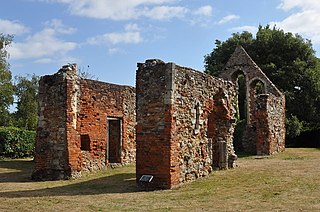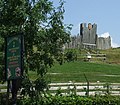
In the United Kingdom, a scheduled monument is a nationally important archaeological site or historic building, given protection against unauthorised change.

This page gives an overview of the complex structure of environmental and cultural conservation in the United Kingdom.

St John's Abbey, also called Colchester Abbey, was a Benedictine monastic institution in Colchester, Essex, founded in 1095. It was dissolved in 1539. Most of the abbey buildings were subsequently demolished to construct a large private house on the site, which was itself destroyed in fighting during the 1648 siege of Colchester. The only substantial remnant is the elaborate gatehouse, while the foundations of the abbey church were only rediscovered in 2010.

St Osyth's Abbey was a house of Augustinian canons in the parish of St Osyth in Essex, England in use from the 12th to 16th centuries. Founded by Richard de Belmeis, Bishop of London, c. 1121, it became one of the largest religious houses in Essex. It was dedicated to Saints Peter and Paul as well as St Osyth (Osith), a royal saint and virgin martyr. Bishop Richard obtained the arm bone of St Osyth from Aylesbury for the monastic church and granted the canons the parish church of St Osyth.

There are 27 scheduled monuments in Maidstone, Kent, England. In the United Kingdom, a scheduled monument is an archaeological site or historic building of "national importance" that has been given protection against unauthorised change by being placed on a list by the Secretary of State for Digital, Culture, Media and Sport; Historic England takes the leading role in identifying such sites. Scheduled monuments are defined in the Ancient Monuments and Archaeological Areas Act 1979 and the National Heritage Act 1983. They are also referred to as scheduled ancient monuments. There are about 20,000 scheduled monument entries on the list and more than one site can be included in a single entry. While a scheduled monument can also be recognised as a listed building, Historic England considers listed building status as a better way of protecting buildings than scheduled monument status. If a monument is considered by Historic England to "no longer merit scheduling" it can be removed from the schedule.

There are ten scheduled monuments in Coventry. In the United Kingdom, a scheduled monument is a "nationally important" archaeological site or historic building that has been given protection against unauthorised change by being placed on a list by the Secretary of State for Digital, Culture, Media and Sport; English Heritage takes the leading role in identifying such sites. Monuments are defined in the Ancient Monuments and Archaeological Areas Act 1979 and the National Heritage Act 1983. Scheduled monuments—sometimes referred to as scheduled ancient monuments—can also be protected through listed building procedures, and English Heritage considers listed building status to be a better way of protecting buildings and standing structures. A scheduled monument that is later determined to "no longer merit scheduling" can be descheduled.
There are more than 1000 scheduled monuments in the county of Dorset, in South West England. These protected sites date from the Neolithic period and include barrows, stone circles, hill figures, ancient Roman sites, castle ruins, and medieval abbbeys. In the United Kingdom, the scheduling of monuments was first initiated to ensure the preservation of "nationally important" archaeological sites or historic buildings. Protection is given to scheduled monuments under the Ancient Monuments and Archaeological Areas Act 1979.
There are 134 scheduled monuments in the county of Bedfordshire in the East of England. These protected sites date from the Neolithic period in some cases and include barrows, churches, castle earthworks, moated sites and medieval priories. In the United Kingdom, the scheduling of monuments was first initiated to ensure the preservation of "nationally important" archaeological sites or historic buildings. Protection is given to scheduled monuments under the Ancient Monuments and Archaeological Areas Act 1979.
There are 287 scheduled monuments in the county of Cambridgeshire in the East of England. These protected sites date from the Neolithic period in some cases and include barrows, churches, castle earthworks, Roman roads, moated sites and medieval priories. In the United Kingdom, the scheduling of monuments was first initiated to ensure the preservation of "nationally important" archaeological sites or historic buildings. Protection is given to scheduled monuments under the Ancient Monuments and Archaeological Areas Act 1979.
There are 121 scheduled monuments in the county of Buckinghamshire, in England. These protected sites date from the Neolithic period in some cases and include barrows, moated sites, ruined abbeys, Iron Age hillforts, a medieval hospital and a holy well. In the United Kingdom, the scheduling of monuments was first initiated to ensure the preservation of "nationally important" archaeological sites or historic buildings. Protection is given to scheduled monuments under the Ancient Monuments and Archaeological Areas Act 1979.
There are 1274 scheduled monuments in the county of Cumbria, in North West England. These protected sites date from the Neolithic period and include barrows, stone circles, Roman forts, standing stones, 19th century industrial sites, abbeys, and ruined castles. In the United Kingdom, the scheduling of monuments was first initiated to ensure the preservation of "nationally important" archaeological sites or historic buildings. Protection is given to scheduled monuments under the Ancient Monuments and Archaeological Areas Act 1979.
There are 931 scheduled monuments in the county of East Sussex, England. These protected sites date from the Neolithic period and include barrows, moated sites, ruined abbeys, Iron Age hillforts, and a hill figure. In the United Kingdom, the scheduling of monuments was first initiated to ensure the preservation of "nationally important" archaeological sites or historic buildings. Protection is given to scheduled monuments under the Ancient Monuments and Archaeological Areas Act 1979.

The Leper Hospital of St Giles is a ruined medieval hospital located in the village of Maldon in Essex, England. Originally established to treat and shelter the town's lepers, it is one of very few surviving medieval hospitals in England. After the dissolution, the building was later used as a barn. The site was designated a scheduled monument in 1923.
There are 563 scheduled monuments in the county of Gloucestershire, England. These protected sites date from the Neolithic period in some cases and include barrows, moated sites, ruined abbeys, castles, Roman villas and tithe barns. In the United Kingdom, the scheduling of monuments was first initiated to ensure the preservation of "nationally important" archaeological sites or historic buildings. Protection is given to scheduled monuments under the Ancient Monuments and Archaeological Areas Act 1979.
There are 273 scheduled monuments in the county of Herefordshire, England. These protected sites date from the Neolithic period in some cases and include barrows, churchyard crosses, ruined abbeys, castles, and Iron Age hill forts. In the United Kingdom, the scheduling of monuments was first initiated to ensure the preservation of "nationally important" archaeological sites or historic buildings. Protection is given to scheduled monuments under the Ancient Monuments and Archaeological Areas Act 1979.
There are 225 scheduled monuments in the county of Hertfordshire, England. These protected sites date from the Neolithic period and include barrows, ruined abbeys, castles, and Iron Age hill forts. In the United Kingdom, the scheduling of monuments was first initiated to ensure the preservation of "nationally important" archaeological sites or historic buildings. Protection is given to scheduled monuments under the Ancient Monuments and Archaeological Areas Act 1979.
There are 208 scheduled monuments in the county of Leicestershire, England. These protected sites date in some cases from the Neolithic period and include barrows, ruined abbeys, castles, moated sites, churchyard crosses and Iron Age hill forts. In the United Kingdom, the scheduling of monuments was first initiated to ensure the preservation of "nationally important" archaeological sites or historic buildings. Protection is given to scheduled monuments under the Ancient Monuments and Archaeological Areas Act 1979.
There are 588 scheduled monuments in the county of Lincolnshire, England. These protected sites date in some cases from the Neolithic period, and include barrows, artillery forts, ruined abbeys, castles, and Iron Age hill forts. In the United Kingdom, the scheduling of monuments was first initiated to ensure the preservation of "nationally important" archaeological sites and historic buildings. Protection is given to scheduled monuments under the Ancient Monuments and Archaeological Areas Act 1979.
There are 689 scheduled monuments in the county of Kent, England. These protected sites date in some cases from the Neolithic period, and include barrows, artillery forts, ruined abbeys, castles, and Iron Age hill forts. In the United Kingdom, the scheduling of monuments was first initiated to ensure the preservation of "nationally important" archaeological sites and historic buildings. Protection is given to scheduled monuments under the Ancient Monuments and Archaeological Areas Act 1979.















